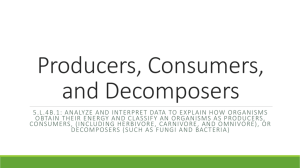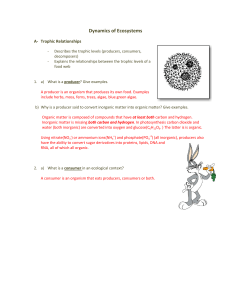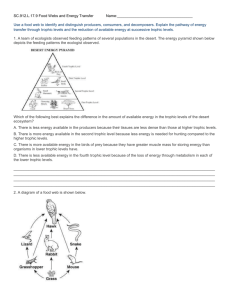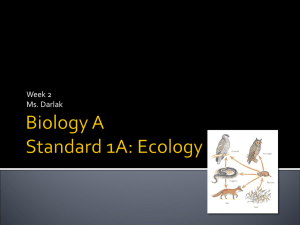Ecosystem Web quest - Moline High School
advertisement
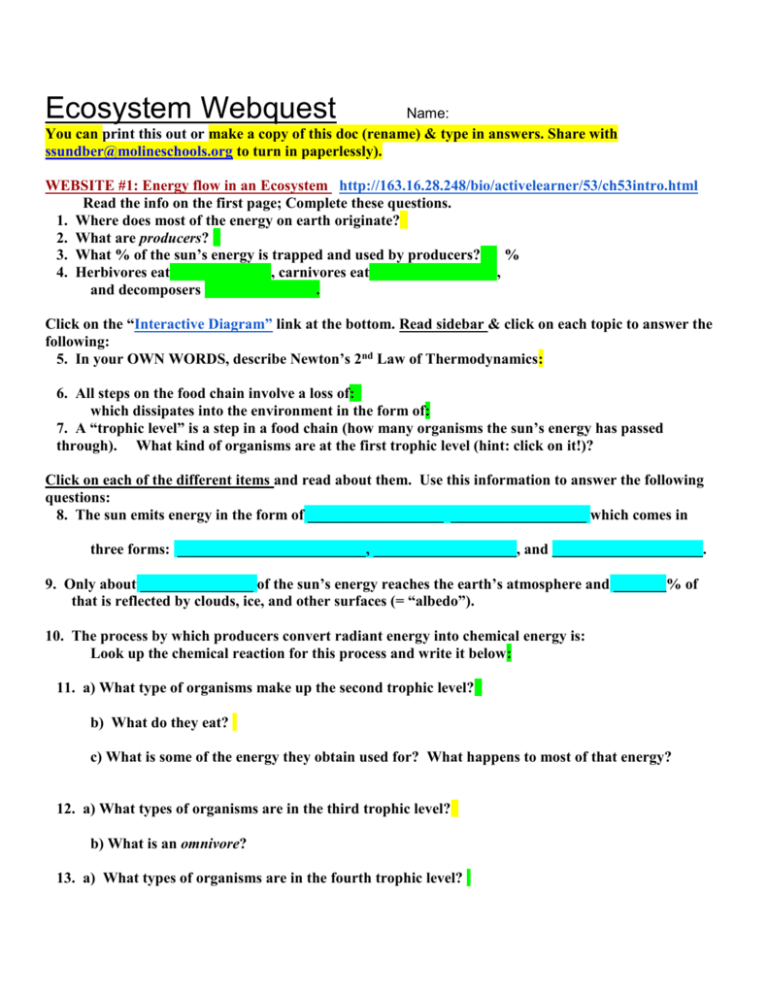
Ecosystem Webquest Name: You can print this out or make a copy of this doc (rename) & type in answers. Share with ssundber@molineschools.org to turn in paperlessly). WEBSITE #1: Energy flow in an Ecosystem http://163.16.28.248/bio/activelearner/53/ch53intro.html Read the info on the first page; Complete these questions. 1. Where does most of the energy on earth originate? 2. What are producers? 3. What % of the sun’s energy is trapped and used by producers? % 4. Herbivores eat , carnivores eat , and decomposers . Click on the “Interactive Diagram” link at the bottom. Read sidebar & click on each topic to answer the following: 5. In your OWN WORDS, describe Newton’s 2nd Law of Thermodynamics: 6. All steps on the food chain involve a loss of: which dissipates into the environment in the form of: 7. A “trophic level” is a step in a food chain (how many organisms the sun’s energy has passed through). What kind of organisms are at the first trophic level (hint: click on it!)? Click on each of the different items and read about them. Use this information to answer the following questions: 8. The sun emits energy in the form of __________________ __________________ which comes in three forms: _________________________, ___________________, and ____________________. 9. Only about _______________ of the sun’s energy reaches the earth’s atmosphere and _______% of that is reflected by clouds, ice, and other surfaces (= “albedo”). 10. The process by which producers convert radiant energy into chemical energy is: Look up the chemical reaction for this process and write it below: 11. a) What type of organisms make up the second trophic level? b) What do they eat? c) What is some of the energy they obtain used for? What happens to most of that energy? 12. a) What types of organisms are in the third trophic level? b) What is an omnivore? 13. a) What types of organisms are in the fourth trophic level? b) How does the number of tertiary consumers compare to primary and secondary consumers? Why? 14. Another term for a decomposer is a __________________. Decomposers break down _____________ molecules from the remains of all trophic levels. They use decomposition products to supply their own ___________ and release molecules such as _______________ & ____________ salts. 15. Decomposers comprise most ____________ and ______________. 16. What do you think would happen if we didn’t have any decomposers? WEBSITE 2: Foodwebs Go to http://www.gould.edu.au/foodwebs/kids_web.htm Look at the questions before you do the foodweb! Use the HINT box to help sort (click on organism picture). 1. In the Austrailian Grasslands food web, identify a/n... a) top predator: c) omnivore: b) producer: d) herbivore: Where did the producers all get their energy? 2. In the African Grasslands food web, identify a/n... a) omnivore: c) scavenger: b) producer: d) decomposer: What organism could be a primary consumer? 3. In the Antarctic food web, identify a/n… a) top predator: b) producer: c) omnivore: d) herbivore: What would happen if the krill went extinct? 4. In the Marine food web, identify a/n... a) top predator: b) producer: What species connects the kelp to the crab? c) Another top predator: d) herbivore: WEBSITE 3: Ecological relationships Quia; http://www.quia.com/pop/123934.html?AP_rand=2005456164 Give 2 examples FROM THIS LINK for each of the following relationships. Your final score? Commensalism: (2 examples for each relationship!) Mutualism: Parasitism: /15



